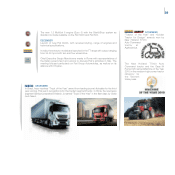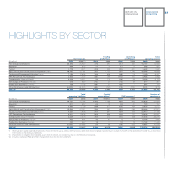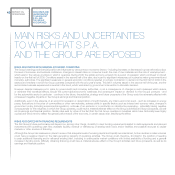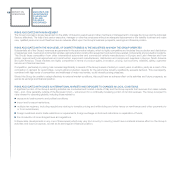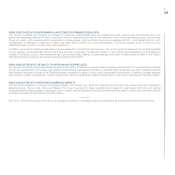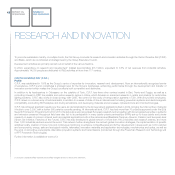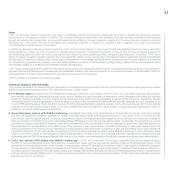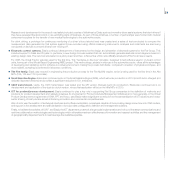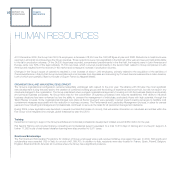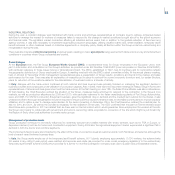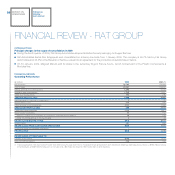Chrysler 2009 Annual Report Download - page 48
Download and view the complete annual report
Please find page 48 of the 2009 Chrysler annual report below. You can navigate through the pages in the report by either clicking on the pages listed below, or by using the keyword search tool below to find specific information within the annual report.
47
Focus
C.R.F. is particularly active in research in the area of sustainable mobility and applies a systematic approach to developing innovative solutions
that embody a 360 degree concept of mobility. This includes minimizing consumption and emissions through innovative propulsion technologies,
as well as lowering fuel consumption by improving overall vehicle efficiency through measures ranging from the use of lighter materials, enhanced
aerodynamics, infomobility, the use of ecological and recyclable materials, in addition to reducing traffic congestion and noise and ensuring
manufacturing processes are eco-compatible.
In addition to alternative fuels and propulsion systems, C.R.F. also conducts research in other areas of particular significance such as energy saving and
energy efficiency in relation to both products and manufacturing processes. Of particular importance on the product front are innovative solutions for
air-conditioning systems which both lower consumption and reduce the direct greenhouse effect (refrigerant gas emissions). In addition, C.R.F. has a
series of research projects in auxiliary systems and, more generally, vehicle energy recovery and management systems (electrical, thermal and hydraulic
energy) aimed at improving efficiency and contributing to achievement of new energy saving standards. As with product-focused research, the objective
for manufacturing processes is to design, build and adapt systems, processes or plants applying energy saving criteria and low environmental impact
technologies, based on a model of environmentally-friendly manufacturing.
C.R.F. is also bringing significant innovation to infomobility, both in terms of the design and implementation of collaborative systems (based on communication
between vehicles and infrastructure) to enable safe and sustainable mobility in the future and services for end customers (based on the Blue&MeTM platform)
that assist drivers to adopt a driving style which reduces fuel consumption and emissions.
C.R.F.’s activities are focused on the following areas.
Powertrain Research and Technology
The principal objective is the development and application of innovative technologies which improve powerplant performance, cutting engine and vehicle
emissions and improving fuel economy. The main achievements in 2009 include:
Fire MultiAir engine. In March 2009, the MultiAir technology was presented to the industry and the media. This new electro-hydraulic valve manage-
ment system reduces fuel consumption (through direct control of airflow through the engine’s intake valves, without engaging the throttle) and polluting
emissions (through combustion control), while at the same time improving performance by increasing torque and maximum power. September saw the
commercial launch of the first application of this new electro-hydraulic valve management system with the naturally-aspirated and turbo versions of the
1.4-litre FIRE gasoline engine. This is the first in a series of forthcoming applications for gasoline engines, which will include the new 900 cc twin-cylinder
engine from the Small Gasoline Engine family. In the future, MultiAir may also be adapted to diesel engines, bringing particular advantages in terms of
emissions, as well as consumption and driveability.
Heavy Duty diesel engines with MultiAir technology. The MultiAir technology is very flexible in terms of application to internal combustion engines
and also has significant potential for application to Heavy Duty (HD) diesel engines (with displacement above 1 litre) used in both commercial and off-
road vehicles, such as agricultural and construction equipment. In light of increasingly restrictive regulations to be introduced on heavy duty engines for
both on-road (Euro VI and EPA 10) and off-road vehicles (Stage 3B/Stage 4 and Tier IV) over the next few years - in particular, the requirement to comply
with limits on nitrogen oxide (NOx) emissions, which will be reduced 80% over current limits - it will be necessary to adopt after-treatment systems for
NOx emissions that are significantly more efficient than those currently in use. The application of MultiAir technology to heavy duty diesel engines will
reduce consumption of both fuel and urea (necessary for the functioning of the SCR system (consisting of tank, line and dosing valve), which represents
a significant cost factor for off-road vehicles, for example. In 2009, the Group launched a project to apply MultiAir technology to one of the Cursor family
engines in an effort to obtain an initial evaluation of its potential benefits by the end of 2010. This prototype application has also been designed to be fully
compatible with the CNG (Compressed Natural Gas) version of the engine, where the benefits of the MultiAir system have already been demonstrated.
Turbo twin-cylinder CNG engine with MultiAir technology. In 2009, FPT Powertrain Technologies completed the pre-production phase of
the 900 cc twin-cylinder bifuel engine (CNG/gasoline). Development began with the twin-cylinder gasoline model (or Small Gasoline Engine), which
represents the ultimate embodiment of the concept of downsizing to reduce CO2 emissions to minimum levels. A high degree of efficiency is assured
through adoption of the MultiAir system for management of the air intake valves, large engine displacement to maximise thermodynamic efficiency, a
minimum number of cylinders for minimal organic losses, and a design that employs the latest standards for minimising internal friction. Compared with
existing naturally-aspirated CNG versions, the turbo provides an additional ‘fun-to-drive’ performance factor. Finally, the engine is flexible, economic
and has very low CO2 emissions.




